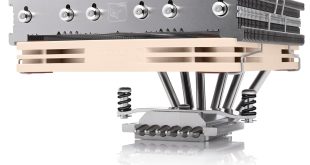The H70 delivers a new fitting design when compared to the older model. Intel solutions use an ‘all in one' back plate system with three holes on each corner to cater for 775, 1156 and 1366. We normally concentrate on mounting these coolers on a 1366 motherboard, but today we decided to show installation on a 1156 ASrock board with an i5 processor.
The ASrock P55 Extreme 4 board we are showing on this installation page features 2 sets of holes cut into the PCB, to allow it to accommodate 775 coolers, even though it is a 1156 based motherboard. This is a cool idea, but when combined with 3 holes on each corner of the Corsair backplate led to a little confusion. What you see above is actually how the backplate has to be fitted, at a slight angle. It looks wrong, but its actually spot on !
The Intel retention ring takes four little ‘plugs' which allows for screws to be threaded through and into the backplate. It looks fiddly, but it only takes a few seconds to get ready.
The retention ring is aligned with the PCB holes and backplate, then they are screwed together. Simple, but again due to our motherboard having two holes on each corner, was a litle trickier.
A simple check on the rear of the motherboard shows that all the screws are threaded in correctly. It is important to leave a little play on the screws at this point as the CPU mount on the H70 has to be inserted under the retention ring, turned clockwise, then locked.
While the image above shows both fans connected to the radiator, it is important to note that one of these has to be connected to the inner wall of the PC chassis.
We removed the rear 120mm fan from our Antec P193 and screwed in the outside fan to the radiator via the chassis.
The images above show the final build with the H70 hooked up to the ASrock motherboard.
Before we go any further however we would like to briefly discuss the recommended fitting approach by Corsair for the H70 (and the H50). They recommend that fans are fitted to suck in cool air from outside the case to be pushed over the radiator – we have noticed two trains of thought on this but KitGuru falls midway between both and we will explain why.

Above we can see an image of the Antec P193 with arrows indicating the method of airflow (before fitting the H70)… fans at the front are used as intake with 3 at the rear/top used as exhaust. This is a traditional airflow design and works well.

Above is how Corsair recommend the H70 should be fitted (far left arrow), sucking in air from outside the case with the 2x120mm fan configuration blowing cool air across the radiator. As there are two fans in the P193 at the top being used as an exhaust this is perfectly acceptable. But what about cases which don't have top mounted fans in exhaust positions?
There would be no exhaust flow at all, with both front mounted and rear mounted fans forcing air into the central area of the chassis. In this instance we would reverse the H70 fan positions to ensure we would have some exhausted air. Remember with a hot running motherboard, memory and graphics card(s) it is important that at least one fan is enabling the removal of warm air. Increased ambient temperatures mean hotter running components.
Let us look at cases which fall outside a ‘traditional designed' ethic.

Above is a side view of the Silverstone Raven 02. The pink arrows are the airflow as Corsair would recommend from the H70, pulling in cool air from outside the chassis (in this instance above).
This is not how we would mount it as the air flow would be fighting against the 3x 180mm fans at the bottom of the case. Again we would reverse the fans on the H70 so all flow was directly from bottom to top.
This may seem like a logical thing to do, but we know many people experienced some problems with the H50, and we are a little concerned that Corsair's stance is always to install the fans in an intake position – sucking in cool air from outside the chassis. This is only ideal with traditionally designed cases with top mounted exhaust fans. If you still don't understand this, then please feel free to discuss it with me on our forums.
 KitGuru KitGuru.net – Tech News | Hardware News | Hardware Reviews | IOS | Mobile | Gaming | Graphics Cards
KitGuru KitGuru.net – Tech News | Hardware News | Hardware Reviews | IOS | Mobile | Gaming | Graphics Cards











